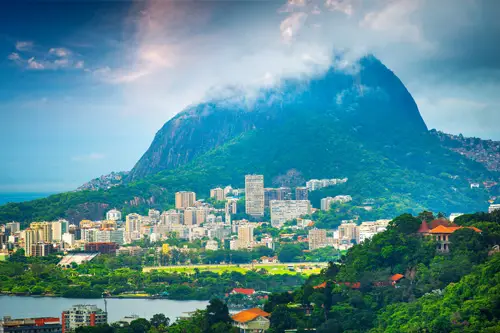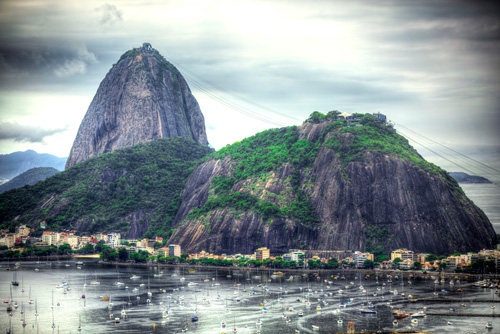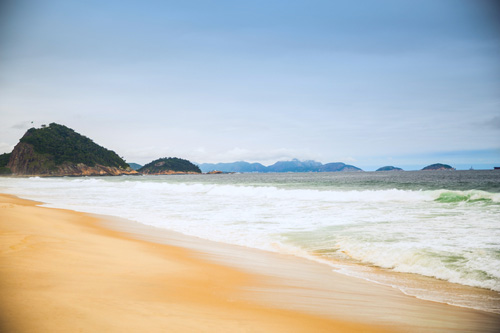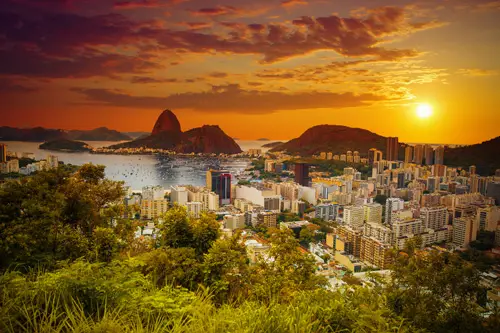Reading Comprehension Text and Exercises
Rio de Janeiro
The Marvelous City
The second largest and most famous Brazilian city, Rio de Janeiro (nickname: Rio) is known for its annual carnival, relaxed beach culture and stunning landscape. Rio charms everyone at first glance – its harbor is surrounded by three green mountains, a lagoon and more than ten beaches.
Local people call it "the marvelous city", which truly is the best way to describe this pearl of the South American continent.

Click Here for Step-by-Step Rules, Stories and Exercises to Practice All English Tenses
A Brief History of Rio de Janeiro
- A Portuguese expedition was the first one to come across the Guanabara Bay on the site of Rio on January 1st, 1502, naming it "January River" (Rio de Janeiro).
- In 1565, the city of Rio was founded around the Guanabara Bay. It quickly became the main port for exporting sugar, gold and precious stones. Being a prosperous place, it was threatened and invaded several times until the 18th century.
- When Napoleon invaded Portugal, the Portuguese royal family and many nobles moved to Rio, making it the capital of the kingdom. For this reason, education and culture in Rio bloomed.
- When Brazil became an independent monarchy in 1822, and later a republic, Rio remained the capital. In 1960, the city of Brasilia became the new capital of Brazil, as the government wanted to separate administration from the cultural and tourist hub Rio had become.
- Nowadays, Rio is certainly the world's capital of football, with its world-class Maracanã stadium, and sports in general, having hosted the 2016 Summer Olympics.

Attractions
Corcovado
Corcovado (meaning "hunchback" in Portuguese) is one of the mountains surrounding the Guanabara Bay. The mountain is covered in the Tijuca Forest, which is also a national park, and it is possible to climb to its peak, which stands at 2,329 feet (710 meters).
The peak is also accessible by train, and it offers a breathtaking panoramic view of the entire city and its surroundings. What Corcovado is most famous for, however, is the giant 125 ft-tall statue of Jesus Christ, called Christ the Redeemer, which stands atop its peak. Overseeing the city, this statue has become the symbol of Rio.
The Beaches of Rio
Many tourists visit Rio on their beach holiday. There are both in-bay and oceanic beaches. Both oceanic, Copacabana and Ipanema are definitely the most popular beaches in Rio, with many songs sang about their beauty.
While it would be hard to surf in the Guanabara bay, since the waves are very clam, these two beaches are perfect places to practice the local way of riding the waves - pegar jacaré (grabbing an alligator), which involves swimming on top of a big wave.
The beaches of Rio are also where tourists can try cheap local food and drinks – a classic cooling beverage is mate com limão, ice tea with lemonade, while empadas are baked pastries with meat or cheese.

Rodrigo de Freitas Lagoon
Located in the South Zone of the city, this beautiful lagoon connects the Atlantic Ocean and the Jardim de Alah Park through a canal, allowing sea water to be a part of the park. There are two islands on the lagoon, mostly used for water sports.
nown as "The Heart of Rio de Janeiro", the lagoon is where locals like to gather to row or bike. The Lagoon is particularly popular during the holiday season – which for Brazilians is summertime – because of a giant Christmas tree which floats around the lagoon on a platform.
Things to do in Rio de Janeiro:
- As a first step to getting to know local food, try "comida a kilo", buffet-style restaurants where you pay by the weight of your plate. An inevitable dish is feijoda, a black bean stew filled with big chunks of meat.
- Enjoy famous local drinks, such as a smoothie made from açaí, a purple fruit from the Amazon forests, or caipirinha, which contains a traditional sugarcane juice liquor.
- Visit in the spring to attend the Rio Carnival, the world's biggest carnival with more than 2 million people celebrating on the streets. You can stand still and watch the samba schools dance, or you can join the party and dance all day!
- Even when the Carnival is over, you can still enjoy traditional dances such as samba and choro all over the city. Some of the best and cheapest nightlife options are available in the Lapa district.

Comprehension Exercises
Vocabulary Questions
- What does "inevitable" mean?
- not very tasty
- cannot be avoided
- hard to chew
- What does "noble" mean?
- king's doctor
- servant to the royal family
- belonging to the richest class
- What does "smoothie" mean?
- drink made with fresh fruit and milk
- done very easily
- having a soft surface
- What does "expedition" mean?
- people expelled from a country
- team of athletes
- journey organized for a particular purpose
- What does "hunchback" mean?
- person whose back has a large lump
- person who climbs mountains
- person who never goes back home
Collocation Questions
- In the 17th century Rio, __________ stones were one of the main exports.
- dear
- precious
- luxurious
- The Portuguese were the first ones to come __________ the Guanabara Bay.
- across
- about
- around
- Rio charms everyone at first __________.
- glance
- look
- peek
- On the Copacabana beach, tourists can try out the local way of __________ the waves.
- balancing
- driving
- riding
- Tijuca Forest is a __________ park.
- republican
- federation
- national
- Feijoda is a stew filled with big __________ of meat.
- chunks
- wedges
- bars
- The Corcovado peak offers a breathtaking __________ view.
- wide
- panoramic
- extensive
- During Christmas holidays, a giant Christmas tree __________ around the lagoon.
- floats
- hovers
- levitates
- Rio de Janeiro is known for its __________ nature.
- outstanding
- stunning
- legendary
- When you see the carnival in downtown Rio, you can stand __________ and observe or join the party.
- quiet
- immobile
- still
Wh Questions
- Why did the Portuguese royal family move to Rio?
- because they loved the beaches
- because World War II broke out
- because Napoleon attacked Portugal
- When did Rio stop being the capital of Brazil?
- Rio was never the capital of Brazil.
- in 1960
- in 2016
- What does "grabbing an alligator" actually mean in Rio?
- surfing
- going to an "all you can eat" restaurant
- climbing the peak of the tallest mountain
- How does the lagoon connect the Atlantic Ocean and the Jardim de Alah park?
- with a bridge
- through a canal
- through an underwater pipe
- Where does açaí grow?
- in the Rodrigo de Freitas lagoon
- all over the Copacabana beach
- in the Amazon rainforest
Evaluating Statements
- Based on the information in this lesson, which statement is true?
- Rio is called "January River" because it was discovered in January.
- Rio is called "January River" because of the amazing Christmas celebration in the city.
- Based on the information in this lesson, which statement is false?
- In "comida a kilo" restaurants, you pay by your own weight.
- In "comida a kilo" restaurants, you pay by the weight of your plate.
True or False?
- Based on the information in this lesson, is the following statement true or false?
"Tourists commonly try the "grab an alligator" surfing on in-bay beaches of Rio." - True
- False
- Based on the information in this lesson, is the following statement true or false?
"In Brazil, Christmas is celebrated in summer." - True
- False
Answer Key
1. B | 2. C | 3. A | 4. C | 5. A | 6. B | 7. A | 8. A | 9. C | 10. C | 11. A | 12. B | 13. A | 14. B | 15. C | 16. C | 17. B | 18. A | 19. B | 20. C |21. A | 22. A | 23. B | 24. A
Get Updates, Special Offers, and English Resources
Download your FREE GIFT (the first two chapters of
English Short Stories Book and Workbook)
as soon as you join!

By submitting your email, you consent to receiving updates and newsletters from us and to the sharing of your personal data with third parties for the purposes of sending you communications. We will not spam you. You can unsubscribe at any time. For more information, please see our privacy policy.





